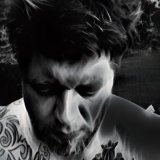
Radoslav Rochallyi
1980 –
Who is Radoslav Rochallyi?
Rochallyi was born in Bardejov, located in the Prešov region of what is today the Slovak Republic in a family with Lemko and Hungarian roots. The author finished his studies in Philosophy at the Faculty of Arts of the University of Prešov (1999–2005) and completed postgraduate PhD studies. He is a member of Mensa, and member of Association of Slovak Writers. He is a Czech-based artist.
Rochallyi is the author of fifteen books. He writes in Slovak, Czech, English and German.
His work includes mainly philosophy, visual arts, and poetry, while linking each of these elements with mathematical symbols. Rochallyi uses mathematical language as an organizational principle and at the same time uses mathematical symbols to describe intonation notation, or to define various types of specifications whose semantics are easier or more effective to express in non-verbal form.
Golden Ratio Poetry
Rochallyi used an experimental poetic form of the golden ratio around 2012.[36] It follows a strict structure based on the golden number 1.618033 in syllables. Typically represented in the form of six lines, 1/6/1/8 / (0) / 3/3 - with so many words or syllables on the line that correspond to the golden number. The only limitation of poetry according to the golden number is the number of words or syllables followed by the sequence number 1.618033. The Greek letter Phi represents the golden ratio. Its value is 1.618034. In Golden Divine collection (2015), he tried to link poetry with Fi (φ) and hence the number 1,618034 in non-graphical form and with a golden section in its graphic form. Schmidt argues that his Golden Divine is a prototype of formal fundamentalism in poetry, employing a restriction according to the Greek letter phi.[38] The only limitation of "Golden Ratio Poetry" is that the number of words or syllables follows the sequence of digits in 1.618034.
Equation Poetry
Equation Poetry uses mathematical language as an organizational principle and at the same time uses mathematical symbols to describe intonation notation (for example, nervous³), or to define various types of specifications that are simpler or more efficient to express in non-text form. Rochallyi claims that every formal rule in poetry is a mathematical rule. This restriction defines the form of poetry. Hence, it can be said that (almost) no form of poetry can do without mathematics. In the Author’s Note in Roanoke Review he mentioned that they both have symbolism, algorithmic basis, structures, formulas, and symmetry. Combining the two is completely natural, as is reading and studying their patterns.
Rochallyi claim that the ambition of Equation Poetry should not be to preserve the meaning of the equation, but to preserve the form, formula and symmetry as accurately as possible. Preserving its full meaning would define the content of poetry and not just form. In such a case, we would not even be making poetry because the resulting poem would be a cluster of precisely positioned words, but without the general meaning. And we wouldn't be creating anything mathematical either; the resulting equation would simply not make sense.
We need you!
Help us build the largest biographies collection on the web!
Citation
Use the citation below to add to a bibliography:
Style:MLAChicagoAPA
"Radoslav Rochallyi." Biographies.net. STANDS4 LLC, 2024. Web. 4 May 2024. <https://www.biographies.net/biography/radoslav-rochallyi/b/bf402da9>.

Discuss this Radoslav Rochallyi biography with the community:
Report Comment
We're doing our best to make sure our content is useful, accurate and safe.
If by any chance you spot an inappropriate comment while navigating through our website please use this form to let us know, and we'll take care of it shortly.
Attachment
You need to be logged in to favorite.
Log In